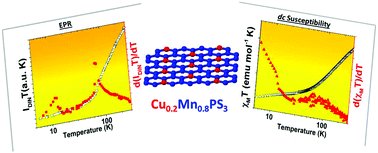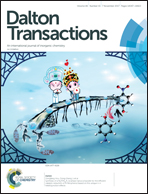Magnetic behaviour of bimetallic layered phases M′0.2Mn0.8PS3·0.25 H2O (M′ = ZnII, CuII, NiII, CoII)†
Abstract
In this work the magnetic properties of bimetallic phases M′0.2Mn0.8PS3·0.25H2O (M′ = CoII, NiII, CuII or ZnII) have been explored and compared with those of the pristine phase MnPS3. Magnetic susceptibility, high field magnetization and electron paramagnetic resonance (EPR) studies reveal that the transition temperature between the antiferromagnetic and paramagnetic order for the pristine phase is shifted to lower values in the bimetallic phases. From magnetization measurements the critical field of the spin-flop transition is found to be dependent on the nature of the added secondary transition metal ion. EPR spectra of all compounds in the temperature range of 8–300 K present a single resonance line shape. Temperature dependence of the EPR parameters, like line width, g values and double integrated area (IDIN), are obtained from the spectra and present a scenario compatible with the magnetization results. The temperature dependence of the first derivative of the product (IDINT) shows two maxima for all samples, with exception of the CoII phase, indicating two critical temperatures, while these critical temperatures could not be clearly determined by dc susceptibility.



 Please wait while we load your content...
Please wait while we load your content...